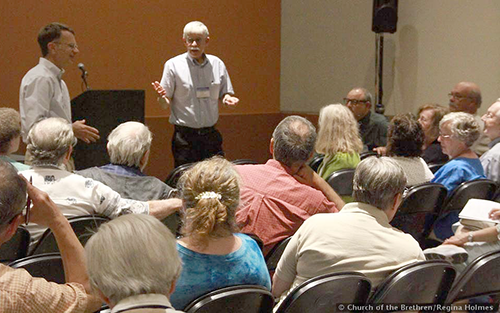July 6, 2018

On June 28, 1914, Archduke Ferdinand was assassinated and a month later Europe was plunged in war. As described by Steve Longenecker, Edwin L. Turner Distinguished Professor of History at Bridgewater (Va.) College, it was the first time modern industrial nations engaged in total war involving entire populations and whole industries. Tens of thousands of soldiers died in a single day of fighting. Economies crumbled. Life changed.
In his presentation for an insight session sponsored by the Brethren Historical Library and Archives and the Brethren Historical Committee, Longenecker focused on the experience of the war and its effects for Brethren.
The United States was shielded from the worst of the calamity for a time, but in 1917 the US entered the war and instituted a draft with relatively few exemptions. War fever led to neighbors spying on neighbors. German-speaking churches were sometimes painted yellow. American flags appeared in churches. German-Americans were harassed and persecuted. Hundreds went to prison.
Brethren, Mennonites, Hutterites, and other non-resistant churches discovered that the vague assurances they may have thought they received from the government prior to the conflict were worthless. With their own leadership caught off guard, the Historic Peace Churches provided little or no counsel to their young draftees, who were carted off to camps. Some of the peace church draftees chose noncombatant service. Others resisted any cooperation with the military. Many were tortured and some died from the treatment.
Longenecker revisited the ill-fated Special Annual Meeting of the Brethren held in Goshen, Ind., in January 1918, that stood up for traditional Brethren values. However, this “Goshen Decision” was repudiated by the church after the government threatened to jail church leaders for sedition. The young Brethren men in the camps were left with no guidance for what they faced.
One result was a rising generation of church leaders who became more proactive in working with the government ahead of the next world war to arrange for Civilian Public Service (CPS), a program that was funded by the churches and not the government. CPS provided an avenue for nonviolent service for those whose faith did not allow them to go to war.
Longenecker told this story anecdotally, with some documentation provided through a handout. The entertaining talk lasted an hour.
— Frank Ramirez contributed this report.
For more coverage of Annual Conference go to www.brethren.org/ac/2018/coverage .
The news coverage of Annual Conference 2018 is made possible through the work of communications staff and a volunteer news team: Frank Ramirez, Conference Journal editor; photographers Glenn Riegel, Regina Holmes, Keith Hollenberg, Donna Parcell, Laura Brown; writers Frances Townsend, Karen Garrett, Alyssa Parker; youth team member Allie Dulabaum; web staff Jan Fischer Bachman, Russ Otto; Cheryl Brumbaugh-Cayford, director of News Services; Wendy McFadden, publisher. Contact cobnews@brethren.org.
Go to www.brethren.org/Newsline to subscribe to the Church of the Brethren Newsline free e-mail news service and receive church news every week.